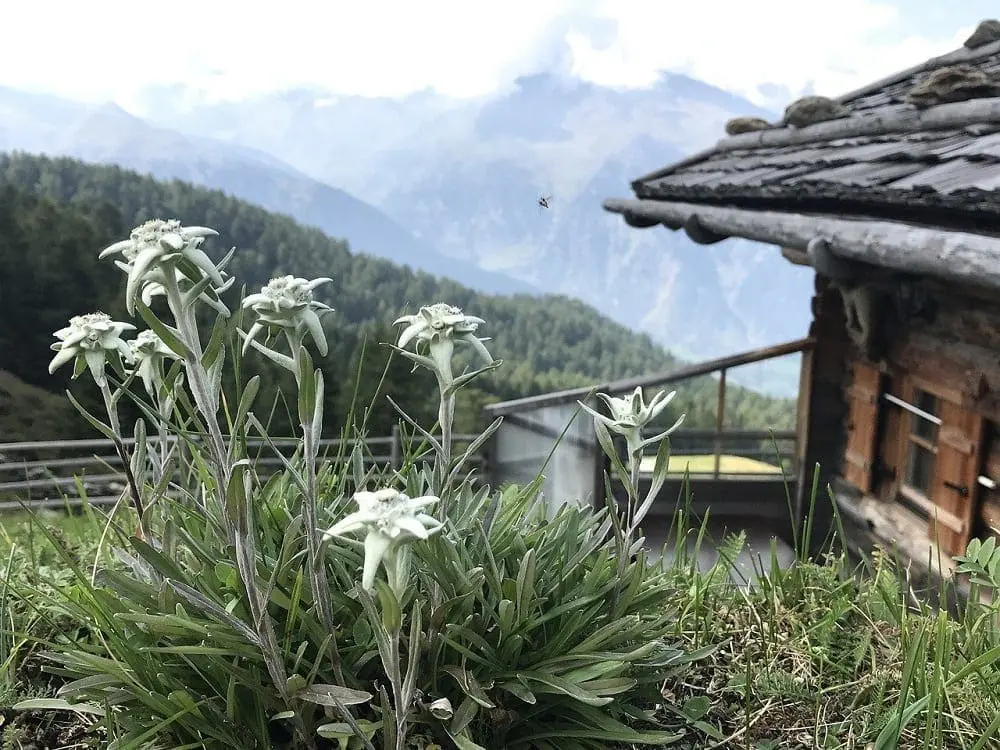When I was a little girl, my Opa sent me a card that had a dried pressed edelweiss flower and a miniature hiker’s axe on it. I loved pulling back the protective cover and petting the soft fuzzy petals. For years that card sat on my bookshelf, and I would imagine the mysterious far-off mountain it came from. You see, I grew up in hot Southern California, and this little Alpine Flower was the stuff of legend! Of mountain climbers and musicals…the favorite flower of Kings and Emperors. Edelweiss is an important symbol for much of the German-speaking world, a symbol of National Pride. To me, Edelweiss was snow (something I didn’t know anything about). So, what is Edelweiss? And how did it achieve mythical status?
What is Edelweiss?
Originally known as Wollblume (wool flower), the plant was first identified by Konrad Gissner, a 16th-century Naturalist. It was also called Klein Löwenfuss (Little Lionfoot), which explains its Latin name, Leontopodium Alpinum (Alpine Lion Paws), as well as Immortelli des Alpus (Immortal Alpine). Edelweiss belongs to the same family as Sunflowers and Daisies… but those high altitudes and cold winters kept the plant small, and the flowers even smaller. In 1785, it was given the name Edelweiss or Noble White… and that’s the name that stuck.
The white “petals” aren’t petals. The actual flowers are quite teensy! It takes over 50 small flowers to create one head that is surrounded by fuzzy white leaves. Yes, the bit we see as flowers are just leaves. Sigh. On the plus side, the fuzzy stuff protects the flowers from cold and ultraviolet rays.

For years, Edelweiss has been used for its medicinal properties. Tea made from the flower is said to aid digestion, and to aid the healing from respiratory illnesses. Swiss farmers would burn the flowers, because they believed that the smoke would treat problems in their cow’s udders.
So how did this fuzzy little flower that Mark Twain compared to “cigar ash” come to have such importance? It dates back to the 19th century when Alpinism (climbing the Alps) became a symbol for strength and courage.

A few Legends
In 1861, the book “Edelweiss” by Berthold Auerbach captured everyone’s attention. A young man risks his life to collect rare Edelweiss flowers for his girlfriend as proof of his daring and bravery. Legends about brave men who went into the Alps and died while picking flowers spread. Edelweiss flowers came to symbolize True and Eternal Love. A love that men and women would DIE for. Mountain climbers furthered this belief with tales of collecting flowers from sheer steep rocks and cliffs of ice.
The problem with Legends like this is that they cause people to behave irrationally. Edelweiss wasn’t really that hard to find in the Alps, and tourists began to pick so much of it that there was a danger of the plant vanishing altogether! In 1878, the Obwalden Canton in Switzerland fought back with the world’s first environmental law that banned people from digging up the flower’s roots! Today the plant is no longer endangered, but it is given protective status (so don’t go around picking it!), especially in Austria where it is illegal!
Also, and this is a biggie…”Edelweiss” is NOT the National Song of Austria. In fact, the song was written in 1959 by Rogers and Hammerstein for the play (and 1965 movie) “The Sound of Music”. Which means… Maria and the Captain never sang it at that concert before slipping away over the Alps… (great story though…)

Edelweiss Today
The magic and mystique of Edelweiss lives on today. It’s a symbol of national pride in Austria and Switzerland. You see it on coins, on military insignia in Austria and among certain Bavarian mountain troops. It’s in jewelry and on clothing. There’s even an Edelweiss Airline in Switzerland! And although you can grow it at home in your garden… this sweet snowflake shaped flower is still a flower of legend, a flower symbolizing courage, and a symbol of true love. A flower that will bring a smile to my face every time I see it.
And that’s enough.
Growing Edelweiss

Edelweiss in Munich’s Viktuelienmarkt
With all the mystique surrounding Edelweiss, you can imagine my surprise when I learned that you could grow Edelweiss in the US! The first time I saw this was at the German Fest in Milwaukee, where a booth was selling the plants to visitors.
Although the flower does best in higher altitudes of 2000 to 3000 meters, it will grow anywhere from zone 3-9, as long as the soil is rocky and well drained. Many people have had great success growing these special little flowers starting from seed, or from seedlings. Just don’t over water them!!
For tips on growing Edelweiss, check out GardenersHQ
Where Can I buy it?
Order seeds here…
Edelweiss- Leontonpodium- 100 Seeds Edelweiss- Leontonpodium- 100 Seeds – –
Edelweiss- Leontonpodium- 100 Seeds – –
Other ways to add this flower to your World…
Edelweiss KeychainRare DirndlEdelweiss Earrings with Freshwater PearlsRare Dirndl
Real Pressed Edelweiss Locket | Silver Stainless Steel Teardrop Locket with Glass https://www.etsy.com/listing/121272866/austria-coin-necklace-pendant-charm
https://www.etsy.com/listing/121272866/austria-coin-necklace-pendant-charm Edelweiss Initial Necklace
Edelweiss Initial Necklace Edelweiss flower – mountain flower – Star of the Alps – Cookie cutter Multi-Size
Edelweiss flower – mountain flower – Star of the Alps – Cookie cutter Multi-Size
Edelweiss Jacquard Woven Kitchen / Tea Towel











Enjoyed reading information about this flower. Such an interesting history.
I’m so glad you enjoyed it!
I recently heard that “edelweìss” is helpful for vascular issues. Could you tell me if this is true?
I will begin with the obvious… I am not a doctor, and can not tell you that a plant will help you with a medical issue. Please do not treat yourself with any herb on my say so.
That said, Edelweiss has been used in traditional herbology for skin conditions, and it looks like some studies are underway to see what affect the plant has on vascular conditions-> https://www.ncbi.nlm.nih.gov/pmc/articles/PMC2682615/